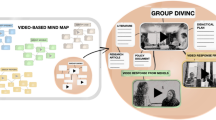Abstract
In this study, the Design Collaboration Model (DCM) was developed to provide a medium for the on-line collaboration of the design courses. The model was based on the situated and reflective practice characteristics of the design process. The segmentation method was used to analyse the design process observed both in the design diaries and the redline files that were composed of the problem domain and the design strategies. In the problem domain, it was observed that high emphasis was given to the design abstractions in the level of details of a space or sub-space. Also, the critics were more interested in the solution space than the problem space. As a design strategy, rejecting a solution was more practiced than proposing alternative solutions. Since the performance score of the students was highly correlated to the number of segments in critiques, it is concluded that quality rather than quantity of critiques determine the success level of proposed design solutions.










Similar content being viewed by others
References
Cheng, N. T., & Kvan, T. (2000). Design collaboration strategies. In The 5th International conference on design and decision support systems in architecture and urban planning (pp. 62–73). Nijkerk, The Netherlands: Ampt van Nijkerk August 22–25.
Cheng, N. Y. (2004). Multiple media in design education’. Retrieved from http://darkwing.uoregon.edu/∼design/nywc/pdf/ecaade-emedia-cheng.pdf (February, 2004).
Chiu, M. L. (1998). The design guidance of CSCW: Learning from collaborative design studios. In T. Sasada, S. Yamaguchhi, M. Morozumi, A Kaga & R. Homma (Eds.), CAADRIA’1998: Proceeding of the third conference on computer aided architectural design research in Asia (pp. 261–270). April 22–24, Japan: Osaka University.
Cicognani, A. (2001). Architectural design for online environments. In B. Kolko (Ed.), Virtual commons: Policy and community in an electronic age. New York: Columbia University Press.
Clancey, W. J. (1997). Situated cognition: On human knowledge and computer representations. New York: Cambridge University Press.
Craig, D., & Zimring, C. (2000). Supporting collaborative design groups as design communities. Design Studies, 20(2), 187–204.
Demirbas, O. O., & Demirkan, H. (2003). Focus on architectural design process through learning styles. Design Studies, 24(5), 437–456.
Demirkan, H. (2005). Generating design activities through sketches in multi-agent systems. Automation in Construction, 14, 699–706.
Dong, A. (2006). Concept formation as knowledge accumulation: A computational linguistics study. Artificial intelligence for engineering design. Analysis and Manufacturing, 20, 35–53.
Fischer, G., & Ostwald, J. (2002). Seeding, evolutionary growth, and reseeding: Enriching participatory design with informed participation. In T. Binder, J. Gregory & I. Wagner (Eds.), Proceedings of the participatory design conference (PDC’02) (pp. 135–143). Sweden: Malmö University.
Gero, J. S., & Mc Neill, T. (1998). An approach to the analysis of design protocols. Design Studies, 19(2), 21–61.
Gero, J. S. (1999). A model of designing that includes its situatedness. In J. Gu & Z. Wei (Eds.), Proceedings of CAADRIA 1999 (pp. 253–364). Shanghai, China: Shanghai Scientific and Technological Literature Publishing House.
Kvan, T., Yip, A., & Vera, A. H. (1999). Supporting design studio learning: An investigation into design communication in computer-supported collaboration. Retrieved from http://sll.stanford.edu/projects/CSCL99/paperindex.html (February, 2004).
Maher, M. L., & Tang, H. (2003). Co-evolution as a computational and cognitive model of design. Research in Engineering Design, 14(1), 47–63.
Riva, G., & Galimberti, C. (2002). Complementary explorative multilevel data analysis CEMDA: A socio-cognitive map of data analysis for Internet research. In G. Riva & C. Galimberti (Eds.), Towards cyberpsychology: Mind cognition and society in the internet age (pp. 19–35). Amsterdam: IOS Press.
Sagun, A. (2003). Evolutionary collaborative design studios. Ph D thesis Bilkent University, Ankara. Available at: http://www.thesis.bilkent.edu.tr/0002366.pdf.
Sagun, A., & Demirkan, H. (2003). Evolutionary collaborative design studios. In E-activities in design and design education—proceedings of 9th europia international conference: E-activities and intelligent support in design and the built environment, October 2003 (pp. 49–59). Turkey: Istanbul Technical University.
Sagun, A., & Demirkan, H. (2005). Usability evaluation of a collaborative web-based design environment In Proceedings of 3rd international conference of innovation in architecture, engineering and construction-AEC2005, June 2005, Netherlands: Rotterdam.
Sagun, A., Demirkan, H., & Goktepe, M. (2001). A framework for the design studio in web based education. Journal of Art and Design Education, 20(3), 332–342.
Schon, D. A. (1987). Educating the reflective practitioner. San Francisco: Jossey-Bass Publishers.
Senyapili, B., & Basa I. (2006). The shifting tides of academe: Oscillation between hand and computer in architectural education. International Journal of Technology and Design Education, 16, 273–283.
Sudweeks, F., & Simoff, S. J. (1998). Complementary explorative data analysis: The reconciliation of quantitative and qualitative principle. In S. Jones (Ed.), Doing internet research (pp. 29–55). Thousand Oaks: Sage Publications.
Swigger, K., Alpaslan, F., Brazile, R., & Monticino, M. (2003). Effects of culture on computer-supported international collaborations. International Journal of Human-Computer Studies, 60, 365–380.
Uluoglu, B. (2000). Design knowledge communicated in studio critiques. Design Studies, 21(1), 33–58.
Vera, A. H., Kvan, T., West, R. L., & Lai, S. (1998). Expertise, collaboration and bandwidth. CHI` 98. Retrieved from http://arch.hku.hk/∼tkvan/chi-98.html (January, 2002).
Zimring, C., Khan, S., Craig, D., Haq, S., & Guzdial, M. (2001). CoOL studio: using simple tools to expand the discursive space of the design studio. Automation in Construction, 10(6), 675–685.
Acknowledgements
We would specially like to thank Dr. Yaprak Sagdic and Dr. Burcu Senyapili who agreed to share time and participate in collaboration sessions with patience and gave worthy design critiques. We are grateful to Projectgrid.com for supporting the project with technical advice and expertise.
Author information
Authors and Affiliations
Corresponding author
Appendix
Appendix
Rights and permissions
About this article
Cite this article
Sagun, A., Demirkan, H. On-line critiques in collaborative design studio. Int J Technol Des Educ 19, 79–99 (2009). https://doi.org/10.1007/s10798-007-9036-2
Received:
Accepted:
Published:
Issue Date:
DOI: https://doi.org/10.1007/s10798-007-9036-2




